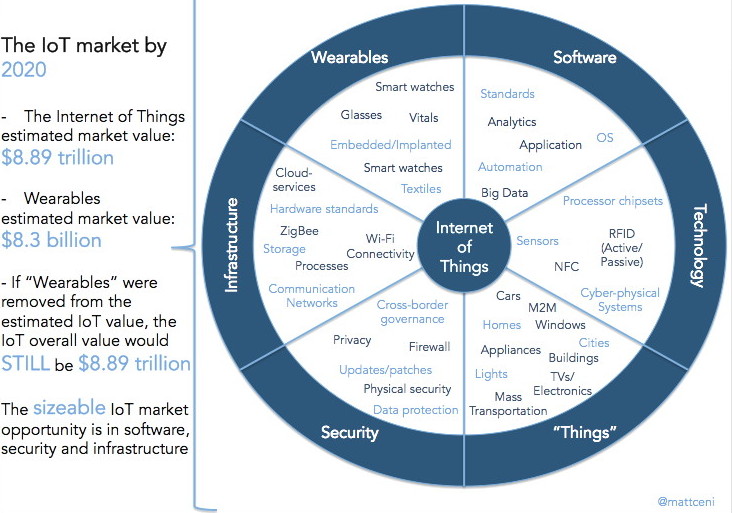 The Internet of Things, abbreviated at IoT, is the trend for more and more things getting connected to the Internet or computer networks via wireless technologies. The 'things' they are referring to can be devices, people, animals or basically any object. The things will be connected via sensors, chips, wearable items or built-in technologies. This is related to machine-to-machine (M2M) technology because most devices in the IoT, so far, are smart machines monitoring other machines. This trend was first names in 1999 but has been developing since the early 1980's. By 2020, it is predicted that the entire Internet of Things will have a market value of $8.89 trillion. IDC expects there will be around 212 billion things in the IoT by the end of 2020, including 30.1 billion installed connected autonomous things, Intel predicts there will be 31 billion connected devices and Cisco predicts 50 billion objects will be connected to the Internet. Gartner predicts these billions of connected "things" will add economic value of $1.9 trillion dollars in 2020.
The Internet of Things, abbreviated at IoT, is the trend for more and more things getting connected to the Internet or computer networks via wireless technologies. The 'things' they are referring to can be devices, people, animals or basically any object. The things will be connected via sensors, chips, wearable items or built-in technologies. This is related to machine-to-machine (M2M) technology because most devices in the IoT, so far, are smart machines monitoring other machines. This trend was first names in 1999 but has been developing since the early 1980's. By 2020, it is predicted that the entire Internet of Things will have a market value of $8.89 trillion. IDC expects there will be around 212 billion things in the IoT by the end of 2020, including 30.1 billion installed connected autonomous things, Intel predicts there will be 31 billion connected devices and Cisco predicts 50 billion objects will be connected to the Internet. Gartner predicts these billions of connected "things" will add economic value of $1.9 trillion dollars in 2020.
1) With lots of things connected to the Internet, there could be a very large explosion of data. However, this data is also a great source for improving the way we manage things if we can design systems to handle and analyze the data.
2) All of the things will need Internet addresses and this could be a potential problem with the Internet infrastructure. It could also spur the development and implemention of improved telecommunication technologies.
3) Both business and home life will become more technical. This will mean that technical skills for average people as well as the need for more technicians will increase. At the same time, better management of various things we do should increase efficiency and thus may decrease the amount of workers needed by businesses and government.